Fred Quillin
It’s impossible for me to tell students to “stop playing around on the computer with Photoshop” and get back to their note taking. As I walked into the classroom recently, my class was busy quietly taking notes for the other professor and one student stood up to ask me a question about Photoshop. I’m sure a traditional Ugandan instructor would have directed him to sit back down and continue with his note-taking because that is what he was “supposed” to be doing at that time. But “playing around with Photoshop” is exactly what I stress the most in my teaching— it’s essential to know certain tools and functions available in the program, but even more important to take the time to experiment and “play around” to see just what the functions do. This particular student shows me a complete FDNC calendar he made for the year 2007.
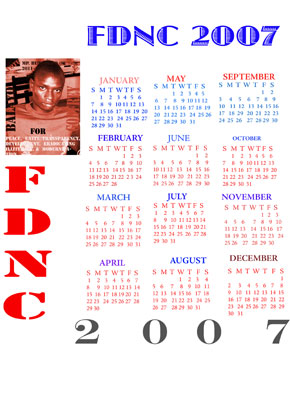
“You made all this yourself?” I ask. “Yes sir.” “When did you do it all?” “Yesterday during the lunchtime.” This young man was so interested in the program that he found a way to be on the computer outside of class time. It was the only way he could work on the computer. I extend class hours when I can, but for several weeks our lab was powered by a generator that had to be turned off at exactly 4pm. For whatever reason, something inside compelled him to make a calendar, and although it is functional, it’s an expression, it’s art. The same student is the one who first showed me something made outside of class by using what I had taught: a mock election poster of himself.

Work by Godfrey Balayo
Some may say the colors in the election poster clash and the design is simple, but it’s easy to see where the influence comes from:
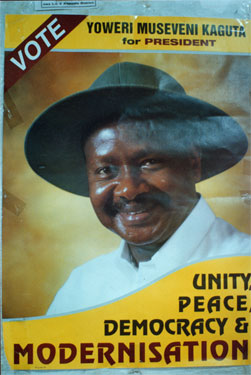
One of the many election posters covering Uganda for current president Yoweri Kaguta Museveni
It makes sense that the first thing students would want to do is edit and manipulate images of themselves as well. Ironically, the first things I ever made with Photoshop on my own were election posters of myself for my high school senior class presidential election. Questions about something new asked by students outside of class are especially welcome because it shows that they’re interested. Such questions have driven my class agenda from the beginning. When I first moved the Mac Mini mouse I accessed the system preferences to see exactly what programs were there and also changed some of the settings. I produced my camera and took a picture of the sky outside the window. After importing the photo to the computer I saw some students were watching me so I opened up Photoshop and began editing the photo, brightening it and making it more saturated, just to demonstrate some of the doors Photoshop can open in image manipulation. I then set it as the wallpaper on the desktop.
One student moved next to me, smiled and introduced himself. He sat extremely close to me. This is probably one of the first lessons I learned while in Uganda, waiting for my ride at the airport and having all the private hire drivers confront me at extremely close range. “Personal space” does not exist here. People are physically comfortable with each other, no matter what sex or what relation (except Muslims who try not to engage in public physical contact of any kind with the opposite sex). People share chairs with each other, sit with arms around each other, and hold hands with each other everywhere. I can’t tell you how many times I’ve asked where a place is in Mbale Town or Kampala and had a large Ugandan man firmly take my hand and walk me blocks down the street to my destination. Very friendly! But very much out of many Westerner’s “comfort zones.”
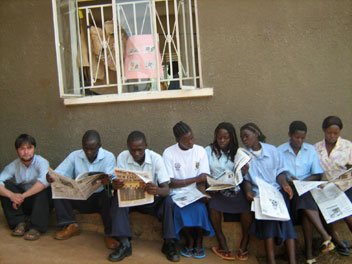
So I explained to this student what Photoshop can do graphically, how it can alter and edit photos, add text, create shapes for all types of formats. I told him how one could create road signs or advertisements or book covers with it, that it can be a powerful tool of communication. I asked him if he had any idea what he might want to learn form me. He said, “I want to do that” and pointed to the screen. “To do what?” I asked. “Put pictures on there.” He was referring to how I had changed the wallpaper image. It amazed me that I was explaining these miraculous possibilities of Photoshop and what it can do and all he wanted to know was the simple task of changing the desktop image with an imported photo. What a cultural difference! So right then I went through the steps and explained everything I was doing and why. I spoke very slowly and articulated. I taught him how to carefully use my camera and had him go through the process afterward, and then a second time to make sure I knew he knew what he was doing. He used a mouse well; all the students in the class had some experience already from their lectures with Microsoft Word and Excel. This student picked up what I was doing and how to navigate through a Mac quickly. I soon learned he was one of the brightest and hardworking in the class.
By this time, of course, five or six other students had gathered around the computer and the new mzungu to see what was happening. Others wanted to try so I did the same for them- explaining first, then allowing each person to do it on their own. I don’t think any of them had used a digital camera before, yet they were all very careful with it. I had them take pictures of each other to import, because I’m sure they’d never seen their own faces on a camera view-screen, let alone a computer. They were extremely excited and more eager to learn than ever. Already we were in an intimate kind of relationship to some degree because of how much fun we were having. Sometimes I had to explain myself again but was very pleased to see the students who had already gone, mainly the first one, helping the new students and guiding then through the exercise. Community. Someone asked if it was possible to make images larger and smaller, so I explained the Free Transform and had each student take their turn. Many more students were helping whoever was at the mouse this time. They were definitely learning. Then someone asked if you could put multiple images into a file, and so we jumped into learning about layers, one of the most important features of Photoshop. That took some time because learning about the layers can be tricky. I tested them by having multiple layers on screen at once and telling them to change a specific one using the Free Transform. To do so they’d have to be on the correct layer, so it was a good way to teach. Remember that at this point there are 15 or more people surrounding this one computer, all learning the same information in a community-type manner as I described before. Finally someone asked if you could put text in, so we learned about that. At some point in the lesson someone asked if this is how newspapers are made.
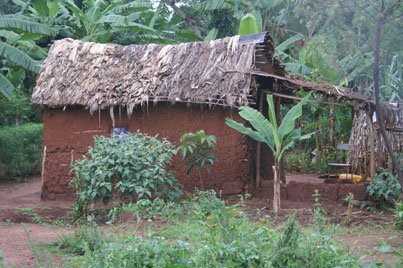
The FDNC Vocational School provides education for students who come from very needy backgrounds, from the surrounding villages mostly. Most of the structures the students come from around this compound and down the street are thatched sticks caked with mud and cow dung for protection against the rain. The closest business establishment is a group of men who smash large rocks into smaller rocks all day long to be made into cement. There’s no name for their business, no sign, and no actual building, save for a few moderate-sized piles of small gray rocks.

What I’m saying is that the people here are very poor. And I realized then that the only kind of advertisements of any kind for FDNC, besides a sign by the road, is the website they have, presumably used for attracting donors and volunteers. But the people in the villages surrounding Mbale Town do not have computers and certainly do not have the Internet, so all students that come here heard of FDNC through word of mouth. Therefore, some kind of tangible newspaper or newsletter that could be printed out and passed around Mbale and the villages or even to Kampala would be extremely beneficial. It could tell about what the students are doing, include pictures of the students and the facility, advertise the art that’s made here (a large revenue-builder), and even include the website address for those with access to the internet. In a word-of-mouth society, like Uganda, something like this would be extremely helpful for an establishment like FDNC, and the skill of knowing how to produce it would be even more useful to the students.
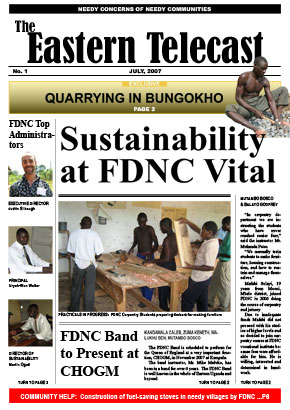
When I asked the students about this, they responded enthusiastically. So this is what the bulk of our work has been. My students have become journalists; learning how to take photos that tell stories and how to conduct interviews with strangers. Most of our time hasn’t even been spent in front of computers- but rather in interviewing all the departments of the organization, which is good because we were without power much of the time. It was a great alternative use of time for computer students who otherwise would have been just sitting around. The students have even begun calling themselves the Journalism Department when they’re in my class. None of this would have happened if I had had a lesson plan. Lesson plans are very structured, very Western. “Just feeling it out” and “playing it by ear” is the organic Ugandan mindset and the strategy I’ve tried to adapt since coming here, in other areas of my life as well. My students are learning a skill they enjoy, unique from any other vocational school in Uganda. This skill could lead to a job they’re actually excited about, and result in a feeling of happiness their bricklaying and tailoring peers may never know. All because they asked questions.











Leave a Reply
You must be logged in to post a comment.